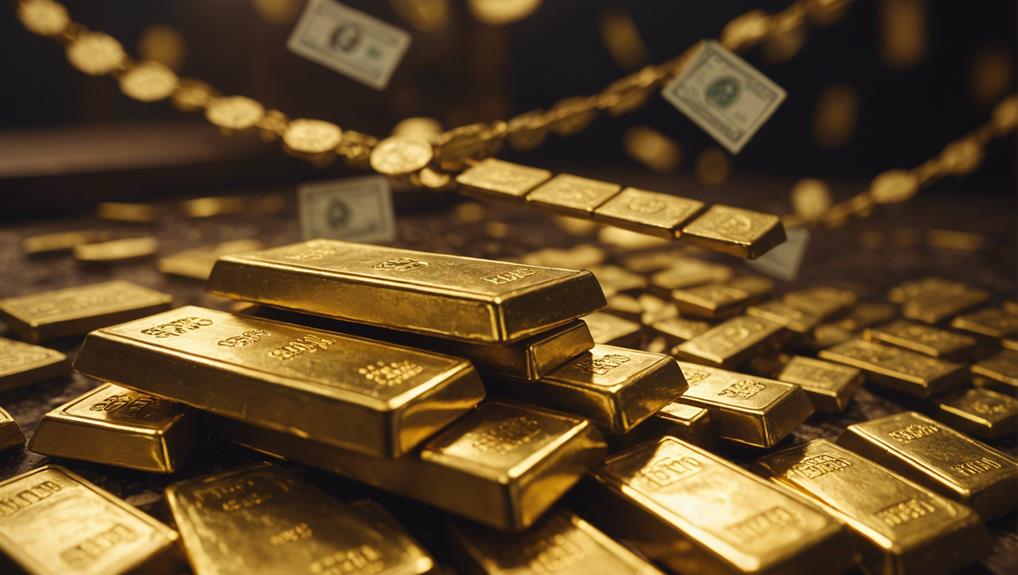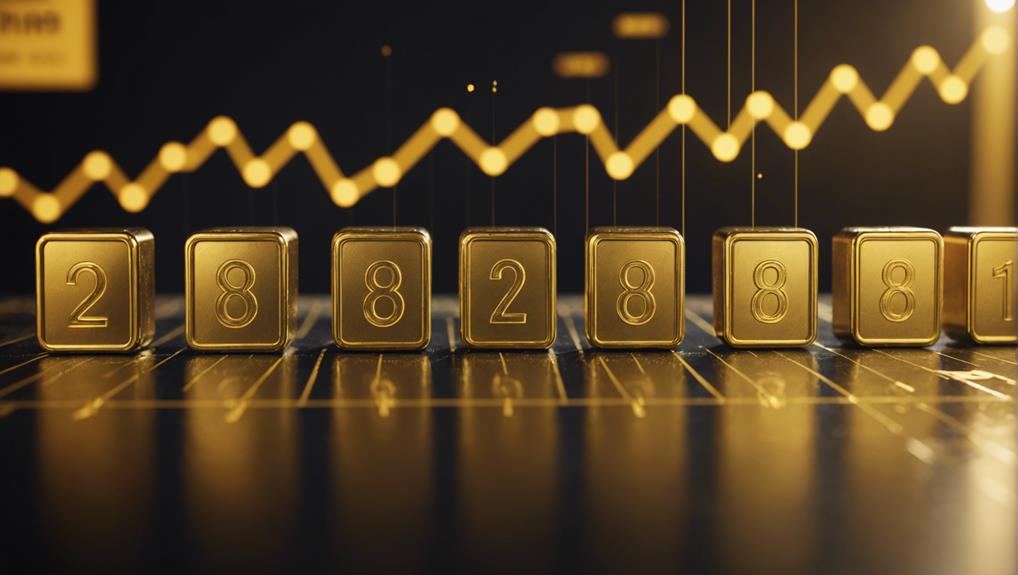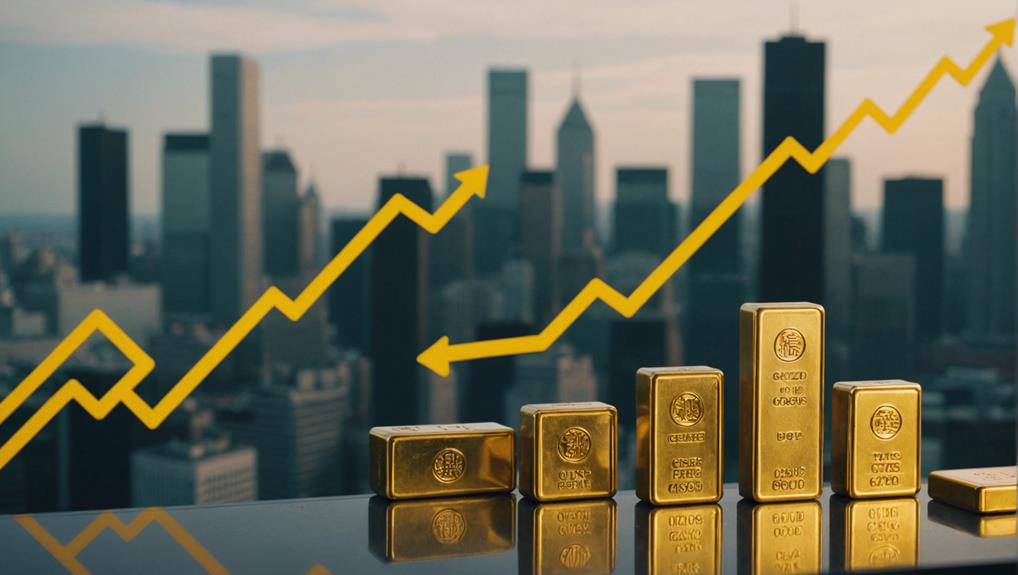Gold's Historical Performance During Inflationary Periods
Historically, you'll find that gold has performed well during inflationary periods, serving as a stabilizing asset when other investments falter. During the 1970s Oil Crisis and the inflation surge of the 1980s, gold prices skyrocketed as investors sought protection against rampant inflation. For example, in January 1980, gold peaked at $850 per ounce when inflation rates were exceptionally high. Likewise, during the 2008 financial crisis, gold's appeal as a safe haven increased significantly. Its inherent value and scarcity make it a reliable hedge against currency devaluation and economic uncertainty, preserving wealth when you need it most. Exploring further could reveal more insights into its enduring appeal.
The Role of Gold in Economic Stability

Gold often serves as a stabilizing force in economies, especially during times of inflation. As you explore the historical context of this precious metal, you'll find that its inherent value provides a hedge against the eroding purchasing power of currency. When prices rise across the board, gold typically retains or increases its worth, offering a safe haven for investors.
This significant characteristic becomes vital in maintaining an equilibrium in financial markets. By investing in gold, you're not only preserving wealth but also potentially mitigating risks associated with volatile economic conditions. Therefore, its allure during uncertain times isn't merely about tradition; it's rooted in proven economic strategies that prioritize asset security and long-term stability.
Analyzing the 1970s Oil Crisis

As you investigate the 1970s oil crisis, you'll notice that the surge in gold prices wasn't merely coincidental. This period offers a critical lens for understanding the broader economic impacts that resonate across global markets.
You'll see how these dynamics played a pivotal role in shaping investor behavior and economic policies during inflationary times.
Gold Price Surge
During the 1970s oil crisis, the price of gold soared as investors sought refuge from rampant inflation. You'd have seen how gold transformed from a stable investment into a critical financial haven. As oil prices triggered economic worries, gold's appeal as a hedge against inflation became more pronounced. Here's a snapshot of gold prices during significant moments of the crisis:
| Year | Gold Price (USD) | Event |
|---|---|---|
| 1973 | $64 | Oil Crisis Begins |
| 1974 | $154 | Inflation Peaks |
| 1975 | $161 | Economic Turmoil |
| 1976 | $124 | Partial Recovery |
| 1977 | $147 | Inflation Resurges |
You're witnessing how gold not only preserved but significantly increased in value, making it a preferred choice for safeguarding assets against economic instability.
Economic Impact Analysis
In the midst of the 1970s oil crisis, economies worldwide grappled with severe disruptions, leading to widespread inflation and unemployment. You'd have seen prices skyrocketing as oil supplies dwindled, impacting everything from manufacturing costs to transportation expenses. The sudden spike in oil prices acted as a catalyst, pushing the cost of living higher and straining household budgets.
Governments struggled to manage the situation, often resorting to wage and price controls which, in turn, distorted market mechanisms further. This period also tested the resilience of different economic sectors, exposing vulnerabilities in energy dependence that hadn't been apparent before. It was a tough lesson in economic interconnectivity and the ripple effects of energy market volatility on global stability.
Gold's Response to 1980s Inflation Surge

The 1980s saw gold's value skyrocket in response to the decade's significant inflationary pressures. You'd have seen this as a clear indicator of gold's role as a hedge against inflation.
During the early part of the decade, inflation rates were exceptionally high, with 1980 itself experiencing a rate of nearly 14%. This economic environment drove investors to seek refuge in gold, pushing its price to unprecedented levels. In January 1980, gold peaked at an astonishing $850 per ounce, a record that stood for decades.
As inflation stabilized towards the late 1980s, gold prices moderated but remained significantly heightened compared to pre-1980 figures. This period highlighted gold's appeal during times of economic uncertainty, reinforcing its reputation as a safe haven asset.
2008 Financial Crisis and Gold

Financial crises often see investors flocking to gold as a perceived safe haven. Historically, when markets plummet, gold's allure increases. You've likely noticed how during severe downturns, like the 2008 financial crisis, gold prices surged as stocks and bonds took a nosedive. It's not merely about its tangibility; gold's scarcity and universal value offer a cushion against currency devaluations and economic uncertainties.
During these times, you might see a pattern: as confidence in traditional investments wavers, the demand for gold spikes, driving up its price. It's a natural reflex for many investors seeking to protect their wealth. Nevertheless, it's important to keep in mind that gold doesn't yield dividends or interest––its value purely reflects market sentiment and demand.
Recent Trends in Gold Investment

You've likely noticed that recent trends in gold investment show a marked increase in its popularity among both seasoned and novice investors. The reasons are manifold, but a few stand out:
- Economic Uncertainty: In times of economic instability, people gravitate towards gold, a reputed safe-haven asset.
- Inflation Concerns: With rising inflation rates, gold is often seen as a hedge against the devaluation of currency.
- Diversification: Investors are looking to diversify their portfolios beyond traditional stocks and bonds.
This surge in interest isn't simply a whim; it's supported by a desire to safeguard and potentially improve personal financial security in uncertain times. As you explore your investment choices, understanding these drivers behind the rising appeal of gold could be vital.
Future Predictions for Gold and Inflation

As you look ahead, consider how gold's role might evolve in response to shifting economic indicators.
You'll need to assess how these changes can impact your investment strategies.
Adaptation will be crucial as you maneuver through the potential ups and downs in the market influenced by inflation trends.
Gold's Role Forecast
Looking ahead, experts predict that gold will continue to be an important hedge against inflation. In the future, you can expect gold to remain a go-to asset during uncertain economic times. This is primarily due to its inherent value and historical performance.
Here are significant reasons why gold will likely continue to play a crucial role:
- Diversification: Gold's low correlation with other financial assets can reduce portfolio risk.
- Stability: Historically, gold has maintained its value over the long term.
- Demand: Increasing interest from emerging markets and central banks enhances its global appeal.
As you explore future investments, keep an eye on gold's enduring qualities. It's not merely a relic, but a resilient player in the financial markets.
Economic Indicators Impact
Several economic indicators significantly influence gold's future performance and its role in mitigating inflationary pressures. You'll find that interest rates are particularly pivotal. When rates are low, gold often becomes more attractive as it doesn't yield interest, making it a competitive alternative to other investments. Conversely, high rates can enhance gold's appeal.
Additionally, the strength of the dollar impacts gold prices inversely. A weaker dollar typically elevates gold prices globally as it becomes cheaper for investors holding other currencies.
Lastly, geopolitical stability plays a role; during times of uncertainty, gold is often seen as a safer investment. Monitoring these indicators can provide insights into potential trends in gold pricing and inflationary trends, helping you gauge the economic landscape more effectively.
Investment Strategies Adaptation
Facing rising inflation, you might consider adjusting your investment strategies to include more gold. Historically, gold has served as a reliable hedge during inflation, preserving purchasing power when currency values decline. As you reflect on your future investment moves, think about these crucial points:
- Diversification: Integrate gold into a diversified portfolio to reduce risk.
- Long-term perspective: View gold as a long-term investment to counteract short-term volatility in inflation rates.
- Accessibility: Consider various forms of gold investments, such as physical gold, gold ETFs, or gold mining stocks.
Predicting future market conditions is tricky, but incorporating gold might provide a buffer against inflation's impact on your other investments, securing your financial stability in uncertain times.
Conclusion
Gold has consistently proven itself as a resilient asset during economic upheavals, particularly when inflation surges. Throughout various crises, such as the 1970s oil shock and the 2008 financial crisis, gold hasn't only preserved its value but often appreciated. Despite its proven track record, it often remains under-appreciated until financial distress becomes palpable.
Reflecting on these observations, it's clear that trusting traditional financial systems and political figures can be precarious. Banks, often structured to serve the affluent, may not always have the best interests of the average investor at heart. This is why controlling one's own finances becomes not just appealing but necessary. Gold offers a tangible sense of security—an asset that doesn't rely on digital promises or political stability.
Given gold's history, it's prudent to consider it a reliable safeguard against economic uncertainty. For those who yearn for more control over their investments and are wary of the conventional banking system's alignment with broader, often elite-driven agendas, gold represents not just an investment but a form of financial rebellion.
To truly understand the value of including gold in your portfolio, consider obtaining a free gold information kit. Knowledge is power, especially when it comes to navigating the murky waters of finance with confidence and autonomy.
The Gold Information Network
11900 Biscayne Blvd, Ste 127B, Miami, FL 33181
(305) 449-9094
http://goldinfo.net
source https://rondewitt.com/golds-historical-performance-during-inflationary-periods/
Comments
Post a Comment